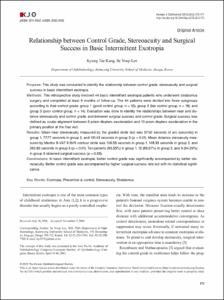Relationship between Control Grade, Stereoacuity and Surgical Success in Basic Intermittent Exotropia
- Keimyung Author(s)
- Lee, Se Youp
- Department
- Dept. of Ophthalmology (안과학)
- Journal Title
- Korean Journal of Ophthalmology
- Issued Date
- 2015
- Volume
- 29
- Issue
- 3
- Abstract
- Purpose: This study was conducted to identify the relationship between control grade, stereoacuity and surgical
success in basic intermittent exotropia.
Methods: This retrospective study involved 44 basic intermittent exotropia patients who underwent strabismus
surgery and completed at least 6 months of follow-up. The 44 patients were divided into three subgroups
according to their control grade: group 1 (good control group, n = 12), group 2 (fair control group, n = 18), and
group 3 (poor control group, n = 14). Evaluation was done to identify the relationships between near and distance
stereoacuity and control grade, and between surgical success and control grade. Surgical success was
defined as ocular alignment between 5 prism diopters esodeviation and 10 prism diopters exodeviation in the
primary position at the final visit.
Results: Mean near stereoacuity measured by the graded circle test was 57.50 seconds of arc (seconds) in
group 1, 77.77 seconds in group 2, and 131.43 seconds in group 3 (p < 0.01). Mean distance steroacuity measured
by Mentor B-VAT II BVS contour circle was 108.33 seconds in group 1, 148.33 seconds in group 2, and
262.82 seconds in group 3 (p < 0.01). Ten patients (83.33%) in group 1, 12 (66.67%) in group 2, and 9 (64.29%)
in group 3 obtained surgical success (p = 0.28).
Conclusions: In basic intermittent exotropia, better control grade was significantly accompanied by better stereoacuity.
Better control grade was accompanied by higher surgical success rate but with no statistical significance.
Key Words: Exotropia, Prevention & control, Stereoacuity, Strabismus
- Keimyung Author(s)(Kor)
- 이세엽
- Publisher
- School of Medicine
- Citation
- Kyung Tae Kang and Se Youp Lee. (2015). Relationship between Control Grade, Stereoacuity and Surgical Success in Basic Intermittent Exotropia. Korean Journal of Ophthalmology, 29(3), 173–177. doi: 10.3341/kjo.2015.29.3.173
- Type
- Article
- ISSN
- 1011-8942
- Appears in Collections:
- 1. School of Medicine (의과대학) > Dept. of Ophthalmology (안과학)
- 파일 목록
-
-
Download
 oak-aaa-00024.pdf
기타 데이터 / 378.09 kB / Adobe PDF
oak-aaa-00024.pdf
기타 데이터 / 378.09 kB / Adobe PDF
-
Items in Repository are protected by copyright, with all rights reserved, unless otherwise indicated.